Top News

July 6, 2016 Ryukyu Shimpo
CHALLENGE Okinawa, which specializes in karate-related products and event production, together with T-shirt designing and production company Ryukyu Piras, have created an Okinawan karate-themed shirt. Shirts are being released in a limited quantity. The creators are promoting sales not only domestically but also internationally. All new products are parts of the “OKINAWA DOJO OF LIFE” brand collection. There are five types of karate shima (island) shirts. The suggested retail price for them is 11,000 yen (excluding tax). There are four types of T-shirts, polo shirts, jackets, and hoodies. The products are sold at Ryukyu Piras Ukishimadori shop, Mihama Depot Island shop, and DOJO Bar, which is managed by CHALLENGE Okinawa.
On July 5 at the Okinawa General Bureau in Naha City, the two companies held a presentation of the new products. A representative of CHALLENGE Okinawa James Pankiewicz said, “All processes from the design to the sewing of the new products are done in Okinawa. We hope the shirts will be worn not only by karate practitioners but also by others like tourists.”
In 2011, CHALLENGE Okinawa opened an international karate bar or the DOJO Bar. While they have already been selling original shirts at the bar, they created a brand to diversify their products.
(English translation by T&CT and Megumi Chibana)
Go to Japanese
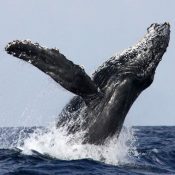
July 7, 2016 Ryukyu Shimpo
Okinawa Churashima Foundation, a general incorporated foundation, in Motobu Town, has published findings from a 21-year research project about the reproductive cycles of humpback whales that visit the ocean around Okinawa. The study focused on the peak season of reproduction when mating and delivery occur, and the analysis was published in an online academic journal.
The study was conducted for 21 years, between 1991 and 2012. In that time, 1,284 random samples of male and female humpback whales’ mating patterns were recorded. The study categorized the structure of groups of humpback whales and made observations on their behavior.
According to the analysis, matching pairs of male and female whales were frequently found from late January to late February. In addition, groups that consist of more than three matching pairs of male and female whales were frequently found. Meanwhile, female samples with calves increased between mid-February and late March. The study estimated that many humpback whales that visit the ocean around Okinawa reproduce from January to late February, and have a gestation period of approximately one year, delivering calves after mid-February.
Okinawa Churashima Research Center staff member Nozomi Kobashi stressed the significance of the study, saying, “Although whale watching is popular, many things about the humpback whale are unknown. This finding will help conservation efforts in future because the tourism industry will be able to avoid disturbing them during their important (reproductive) process.”
(English translation by T&CT and Sayaka Sakuma)
Go to Japanese

July 6, 2016 Ryukyu Shimpo
On July 6, a sit-in protest in front of the gate of Camp Schwab marked two years since the start of action to block construction of a new U.S. base in Henoko, Nago. The governments of the United States and Japan plan to build an airfield there to replace U.S. Marine Corp Air Station Futenma. Citizens staging the sit-in delivered speeches and renewed their determination to continue their struggle for the third year. Akutagawa Prize winning novelist Shun Medoruma who has previously protested from a kayak on the water surrounding the base, referred to the construction being halted, saying, “Every one of those protesting rose to their feet and with their courage challenged the governments of the United States and Japan and forced them to stop the construction. I would like to confirm this fact with confidence. Let’s make them not ‘halt’ the construction but ‘give it up.'”
(English translation by T&CT)
Go to Japanese
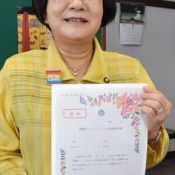
July 8, 2016 Ryukyu Shimpo
Naha City introduced a new system on July 8 officially recognizing same-sex partnerships and will begin issuing partnership certificates to same-sex couples. The system recognizes same-sex partnerships as almost equivalent to marriage in law, aiming to make Naha a city that does not tolerate discrimination and prejudice against sexual minorities. According to Naha City, it is the fifth local government in the country to adopt such a measure and the first in the Kyushu/Okinawa area.
The system’s principles state that the Naha city office will issue certificates recognizing partnerships of same-sex couples living in the city who are aged 20 or older. Application details will be confirmed and certificates will be issued after one week. The municipal government said the certificates will be used by same-sex couples applying to move into city-owned residences and medical institutions.
From July 8, the city started accepting applications by phone. The application forms can be downloaded from the city’s website, with submissions starting on July 10.
(English translation by T&CT)
Go to Japanese
July 11, 2016 Ryukyu Shimpo
Okinawa will not be daunted by the hardline stance of the Abe administration. The election results are a sign of the indomitable resolve of the Okinawan people with a steady eye on the future.
Yoichi Iha, the non-party affiliated former mayor of Ginowan City, was newly elected to the Upper House of the Japanese Diet representing the Okinawa electoral district. He won an overwhelming victory on a platform opposing the construction of a new base in Henoko, Nago City as part of the relocation of U.S. Marine Corps Air Station Futenma.
The “All-Okinawa” faction now holds a total of six seats in the Diet: two seats representing Okinawa in the Upper House (one of which was not up for election this time), and four seats representing Okinawa in the Lower House.
Opposition to the new base construction has taken on new weight. It is inadmissible for the Abe administration to ignore the will of the people and push forward forcefully with the new base construction.
In a vote, a vow
Iha defeated his opponent, Minister of State for Okinawa Affairs Aiko Shimajiri, who was aiming for a third term in office, by a wide margin of nearly 110,000 votes. This is proof that the popular will rejecting the construction of a new base in Henoko is unwavering. It is highly significant that Okinawans have once again declared to the Japanese government that they wish to realize self-determination, with Okinawa deciding its own path.
In the wake of a rape and murder by a U.S. military contractor that occurred as a result of the presence of the U.S. bases, the results of the election also reflect a vow on the part of Okinawans that we must put an end to the harm caused by the bases.
In his campaign, Iha expressed opposition to the new base construction, saying that the construction of a new base in Henoko will not result in a reduction of burden on Okinawa. By relocating the base to Henoko, “Okinawa will remain an island of bases forever,” Iha said. His words penetrate the true nature of the unreasonable way in which the bases are foisted on Okinawa, and the number of votes he received is evidence of the widespread resonance of his message among the people.
Building a new base will only continue to force an excessive burden on Okinawa alone, and will do no more than shift the dangers to a new location. The results of the election once more force the Abe administration to face the fact that this view is the consensus in Okinawa.
Shimajiri claimed that she would work as hard as she could and in a practical way to deal with the Futenma issue without eliminating any options. However, the Abe administration eliminates every other option and insists on the Henoko relocation. Shimajiri also declared that the fundamental issue of the Futenma problem is the elimination of danger and the reduction of the base burden on Okinawa. However, given how long it will take to build the new baes, the government’s plan will leave the dangers of Futenma in place for at least ten more years. It is no wonder that this stance did not win the support of Okinawans.
By revoking the campaign pledge she made to voters in the Upper House election six years ago to work to have Futenma relocated outside of Okinawa, Shimajiri became a spokesperson for the Abe administration. What Okinawans want is a spokesperson who represents their will. The presence or absence of this realization had a significant effect on the election results.
The Abe administration must not avert its eyes from the fact that the Henoko base construction plan has been rejected by Okinawans. It must also realize that the major defeat of a sitting Minister of State constitutes a strong protest against the fact that the government is unable to come up with effective measures to prevent incidents caused by U.S. military personnel and civilian workers.
Going back to fundamentals
Candidates rejecting the new base construction were victorious in all of Okinawa’s recent elections in which the Futenma relocation issue was a main point of contention—in 2014, the January Nago mayoral election, the November gubernatorial election, and the December Lower House election.
In the Ginowan mayoral election in January of this year, the incumbent mayor, who was supported by the Abe administration, was victorious. However, during his campaign he did not clearly state either support for or opposition to the Henoko relocation plan. His win did not represent a choice by the city’s electorate in favor of the new base construction. In the prefectural assembly election in June of this year, Governor Onaga’s ruling party won a resounding victory.
It is clear from the fact that the “All-Okinawa” faction now holds all the seats representing Okinawa in both houses of the Diet that there is absolutely no chance of Okinawans accepting the new base construction.
Nonetheless, Prime Minister Shinzo Abe has declared his intention to continue promoting the Henoko relocation despite Iha’s election. Forcefully pushing forward with the new base construction is nothing but a destruction of democracy. Validity is on Okinawa’s side. It is only just that the opinion of those who will be most disadvantaged should be respected.
Based on the results of numerous elections, Governor Takeshi Onaga referred to Iha’s victory as a “final settling of accounts” in terms of the expression of the will of Okinawans. Hopefully, this will have been the last election in which the new base construction is a point of contention.
It is not difficult. Okinawans have rejected the Henoko base construction on the grounds that it will not contribute to a reduction of burden, and if the Abe administration would give up on the plan, the problem would be over. Going back to the fundamentals of democracy, that is the natural turn of events.
(English translation by T&CT and Sandi Aritza)
Go to Japanese
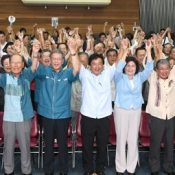
July 11, 2016 Ryukyu Shimpo
Former Ginowan Mayor and independent new candidate Yoichi Iha, 64, won a seat for the first time in the Okinawa prefectural constituency in the July 10 Upper House election.
He beat the incumbent state minister for Okinawa and Northern Territories Affairs Aiko Shimajiri, 51, who ran for the LDP, with support from the party’s junior coalition partner Komeito, by a wide margin of 106,400 votes, capturing 356,355 votes.
Iha’s victory means that the “ALL Okinawa” camp, which opposes the government’s plan to relocate the U.S. Futenma airfield to Henoko in Nago, has captured all the seats representing Okinawa constituencies, including both of the two upper house seats and all four lower house seats.
While the ruling LDP party claimed victory across the nation, the voters in Okinawa judged the Abe administration severely for pressing forward with the Henoko relocation plan and the revision of the constitution.
Iha won broad support from voters, highlighting the Henoko issue and using the catch phrase “a peaceful Okinawa with no bases.”
He received full support from the “ALL Okinawa” camp, including the ruling party of the Onaga administration, Shimpu-kai, which is a conservative group in the Naha city council, as well as labor organizations and some business groups. He also gained some conservative votes with the help of Governor Takeshi Onaga, who has a high popularity rating.
He attracted political independent voters with achievements in welfare policy during his term as Ginowan City Mayor, and by highlighting partnerships with the prefectural government towards promoting economic development.
Shimajiri staged her election campaign with the support of conservative prefectural assembly members, municipal government heads and business leaders. Nonetheless, she faced a tough situation from the beginning of the campaign, receiving a strong negative reaction from voters. She previously won a second term in the 2010 Upper House Election on a pledge to relocate the Futenma base out of the prefecture, however she withdrew the pledge later.
Shimajiri emphasized her achievements in gaining funds for economic development and for poverty support measures for children during the campaign. But the alleged murder and rape of a 20-year-old Okinawa woman by a U.S. civilian base worker in April triggered anti-U.S. base sentiment. And, some conservative voters turned against her.
New candidate Tatsuro Kinjo, 52, who was backed by the Happiness Realization Party, gained 9,937 votes.
Voter turnout stood at 54.46 percent, up 1.03 points from the 2013 Upper House election. In the basic voter lists, the number of voters, including those abroad, was 1150,806 voters (560,368 male voters and 590,438 female voters)
(English translation by T&CT)
Go to Japanese

July 2, 2016 Ryukyu Shimpo
A series of picture books exemplifying the appeal of eisa in Okinawa City is now complete with the publishing of the fourth and final book, Dreams of Eisa. Copies of the book are being distributed to schools within Okinawa City. The other three titles in the series are Spirit of Eisa, Bonds of Eisa, and Circle of Eisa. One book in this series has been published each year for the purpose of educating the next generation about eisa dance. The books are meant to spark attraction to eisa inside and outside Okinawa in preparation for the Okinawa Zento Eisa Matsuri in the summer.
Production of the picture books started in 2007, correlating to the Eisa Town Declaration as one form of public relation activity by Okinawa City. One book was published each year starting in 2013. The actor Yuto Fujiki has written the text for all four books.
Protagonists in the book series are Okinawa City’s eisa mascots Eibo, Sachan, Takun, Sanaji, and others. The books explain the origin of the eisa as an event held annually at Obon, and the role of the community center in contributing to activities in the region. Additionally, the books teach the importance of empathizing with others through the lens of eisa dance.
In the final book, Sanaji jumps back through time to witness historical events such as the first eisa competition in 1956, which sparked the Okinawa Zento Eisa Masturi. He also has dreams depicting the future.
Each book in this series has about 1,000 copies published. The books have been distributed to daycare centers, kindergartens, schools, and libraries; equal to about 318 locations altogether. Copies are not available for sale. These books were the work of the Okinawa City Tourism Product Promotion Association and can be read on Okinawa City’s public sightseeing website Koza Web.
Please direct inquiries to the Okinawa City Hall Culture and Tourism Division at +81 098 (939) 1212, extension 3505.
(English translation by T&CT and Erin Jones)
Go to Japanese
July 5, 2016 Ryukyu Shimpo
The issue of alien species invasion feared to occur due to soil being brought in from other parts of Japan as part of the new Henoko base construction will be discussed at the General Assembly of the International Union for Conservation of Nature (IUCN) in September. Having received a proposal from the Nature Conservation Society of Japan and other organizations, the IUCN General Assembly will vote on a proposed recommendation to the Japanese government.
Six Japanese environmental conservation organizations have been criticizing the plan to relocate U.S. Marine Corps Air Station Futenma to Henoko, calling for the conservation of the dugong, sea turtle, coral, and other rare life forms, as well as the natural environment.
The IUCN, which is the international authority on environmental conservation, made a recommendation to the Japanese government that the dugong be protected three times, in 2000, 2004, and 2008, but the Japanese government turned its back on international opinion regarding nature conservation and is moving forward aggressively with the Henoko base construction.
2,100 cubic meters of soil, enough to fill the Okinawa Prefectural Office 70 times, is planned to be used to fill in the sea in the Henoko land reclamation. Reclamation of sea areas alone is destructive to marine ecosystems, and the additional issue of the impact of alien species mixed into the soil brought in from other parts of the country is also garnering attention.
The reclamation plan involves shipping soil to Okinawa from seven locations and six prefectures around the country. These locations are confirmed to be home to nine animal species that are poisonous or likely to exterminate native species, such as the Argentine ant and the redback spider. If these species invade the environment, they could have a devastating effect on native ecosystems.
In November of last year, an ordinance that restricts bringing in soil containing alien species came into effect, but there are doubts as to its effectiveness. It may not be possible to conduct an infallible check of every inch of the massive amount of soil needed to reclaim a vast area of sea in order make sure none of it contains any microscopic harmful organisms.
Three villages in the northern part of Okinawa were just designated as Yambaru National Park, and that area is now a likely candidate for designation as a World Heritage nature site. If alien species are allowed to invade the nearby Henoko area, it could have an impact on the unique flora and fauna and the biodiversity of the northern Yambaru region.
In 2010, Japan served as the chair at the Conference of the Parties to the Convention on Biological Diversity. It is the responsibility of the Japanese government to sincerely address the discussion on the proposed recommendation regarding measures to deal with alien species to be deliberated by the IUCN General Assembly.
World Heritage nature sites are designated based on a recommendation by the IUCN. The way in which the government addresses the issues of alien species and impact to the dugong caused by the Henoko base construction could end up crucially affecting Yambaru’s designation as a World Heritage nature site.
Nago Mayor Susumu Inamine will be attending the IUCN General Assembly in September. A representative from the Okinawa prefectural government ought to attend as well. It is hoped that the Nature Conservation Society of Japan and other organizations in Japan and Okinawa will join together and work to increase international pressure to stop the ill-advised plan to build a new base in Henoko.
(English translation by T&CT and Sandi Aritza)
Go to Japanese
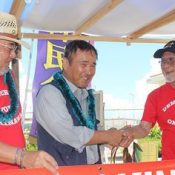
July 4, 2016 Ryukyu Shimpo
Robert Nakasone, a resident of Hawaii who is a second-generation Okinawan visited the sit-in protest site in front of the gate of Camp Schwab in Henoko, Nago on July 2. He presented Hawaiian leis to citizens protesting against the construction of a new U.S. base in Henoko.
Nakasone said in his speech, “We can understand the hardship that Okinawa suffers because we have deep exchanges between Hawaii and Okinawa. We present Hawaiian leis, which mean that we always stand by you and support you.”
Hawaiian women including those of Okinawan descent made about 50 leis after they decided to present them three weeks ago.
Yasuhiro Maeki, 31, from Okinawa City, returned the courtesy performing an eisa dance for Nakasone.
(English translation by T&CT)
Go to Japanese

June 24, 2016 Ryukyu Shimpo
A memorial service for the war dead was held at Zuisen Monument in Komesu, Itoman on June 23. The names of students from the former prefectural Shuri Girls’ High School are inscribed on the monument. A junior high-school student read a “Message for Peace,” which was the first time such a message had been read at this event. A senior-year Shuri Junior High School student, Yuto Kuba, said he had taken over the will of his grandfather who lost seven out of eleven family members during the Battle of Okinawa. He pledged, “I would like to think about how never ever to repeat disastrous war on this land.”
Students from Shuri Girls’ High School were assigned at field hospitals as nurses during the deadly battle.
Kuba’s 80-year old grandfather, Satoshige, lost his seven family members including his older sister who was also a student of the school. It is unknown where and when the family members died, so he decided on June 23 as everyone’s death anniversary.
Kuba has been attending the memorial service since he was in kindergarten, but he says he did not really understand its meaning at the beginning. He shared how he “started to think how horrible war is” as he listened to his grand parents’ experiences. He further stressed, “from now on, we younger generations will take over the stories and lessons from you and pass them on to the next generations.”
After the service, he remarked, “I don’t want allow any causes for war anymore. I shared my message hoping for a continuous peace. I hope we young generations attend these kinds of events actively from now on.”
His grandfather, Satoshige, who lost a total of eight family members including his aunt said he expects his stories to be passed on, “I think my grandson felt something when I took him to the memorial service every year. I hope our grandchildren will think about war and peace.”
Sadako Niimoto, the chairman of Zuisen Alumni Group, which consists of graduates of Shuri Girls’ High School and former Prefectural Girls’ School of Arts, shared the purpose of having a junior high-school student’s message; “I hope this provides good opportunities to young generations, who will build the future, to think of what war is, and to have their own sense of responsibility in peace-building.”
(English translation by T&CT and Sayaka Sakuma)
Go to Japanese
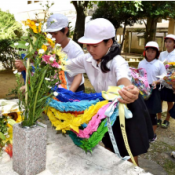
July 1, 2016 Ryukyu Shimpo
Fifty-seven years have passed since June 30, 1959, when a U.S. F-100 fighter, which was poorly maintained from Kadena Air Base, crashed into Miyamori Elementary School in Ishikawa City (currently Uruma City).
The Ishikawa and Miyamori 630 Association and the bereaved family association held the 57th anniversary memorial ceremony on June 30 at the school. Participants paid their respects to the 18 victims. They had a moment of silence at around 10:40 a.m., which was the time when the aircraft crashed. About 100 bereaved family members, people who were pupils at time of the crash, and local residents attended. Prior to the ceremony, the school’s student association held a ceremony to pay tribute to the memory of the victims.
Representing the students, 11 year-old Karen Igei who chimed a peace bell, said, “I want the victims to rest in peace.” During the ceremony, U.S. military aircraft generating loud noise flew over the pupils taking part.
Seventy-nine-year-old Hideko Iha who lost her mother because the fighter also crashed into her house, took part in the ceremony. Iha said, “I pray every year for a lasting peace that will not let such a tragedy happen again.”
Haru Arakaki who lost her son due to injuries from the accident, offered incense sticks. Arakaki tearfully said, “I came here to pray and I want you to watch out for us.”
Yoshimori Uema who lost his brother, represents the bereaved family association. Uema said, “I think you would have become a fine business person if you did not die. We lost invaluable lives. The accident happened because of the existence of military bases in Okinawa.” Referring to the large number of accidents involving F-100 fighter that continued to be deployed in Okinawa even after the accident, Uema said, “After the accident, I heard that there were fighters loaded with nuclear warheads. It was ridiculous.”
Masaharu Kudaka, the head of the Ishikawa and Miyamori 630 Association said, “It was the biggest crash since the war. We need to firmly recognize how serious and grave the crash was.”
(English translation by T&CT)
Go to Japanese









 Webcam(Kokusai Street)
Webcam(Kokusai Street)


